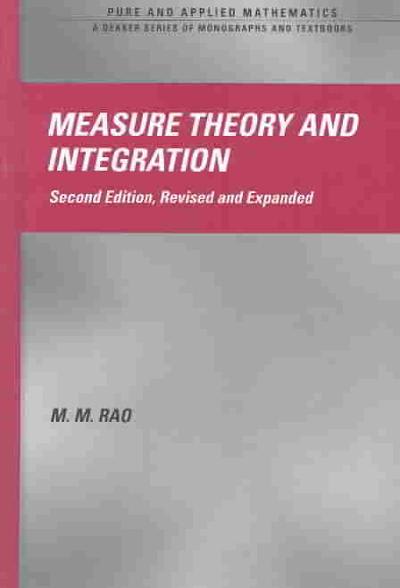Question
CHAPTER 8 1. Consider using the multiplication rule when simple outcomes are connected by the word a) and . b) if . c) but .
CHAPTER 8
1.Consider using the multiplication rule when simple outcomes are connected by the word
a)and.
b)if.
c)but.
d)or.
2. On the assumption that voters do not prefer either of four candidates, the probability of a vote for one of these candidates, say candidate A, equals
a) 1/2.
b) 1/3.
c) 1/4.
d) none of the above
3. Two outcomes are mutually exclusive if
a) they can't occur together.
b) the occurrence of one outcome has no effect on the probability that the other outcome will occur.
c) their two probabilities sum to one.
d) their probability of occurring together is greater than zero.
4. When taking a random sample of ten students from a large class that contains about equal numbers of males and females, you obtain nine males and only one female. This particular outcome is
a) impossible.
b) unlikely, but possible.
c) proof that the sample isn't random.
d) just as likely as any other outcome, such as six males and four females.
5. Pollsters conduct surveys based on
a) real populations.
b) hypothetical populations.
c) either real or hypothetical populations.
d) neither real nor hypothetical populations
6. Typically, sample size is
a) large.
b) less than 100.
c) small relative to the population size.
d) less than one-hundredth of 1 percent of the population size.
7. In inferential statistics the likelihood of erroneous generalizations can be
a) eliminated.
b) controlled.
c) ignored.
d) bypassed.
8. A random selection of registered voters within the state of Nevada guarantees that
a) at least some registered voters will be selected from Reno.
b) at least some registered voters will be selected from each county.
c) all registered voters have an equal chance of being selected.
d) all registered voters will be adequately represented.
9. Consider using the addition rule when simple outcomes are connected by the word
a)and.
b)if.
c)but.
d)or.
10. You might choose to survey an entire population if the population is
a) small.
b) accessible.
c) real.
d) important.
CHAPTER 9
11. In serious applications, sampling distributions are
a) constructed from scratch.
b) restricted to relatively few possibilities.
c) employed only at the outset of the analysis.
d) deduced from the theory of statistics.
12. Greek letters are used to describe characteristics of
a) samples and populations.
b) samples and sampling distributions.
c) sampling distributions and populations.
d) samples, sampling distributions, and populations.
13. A random sample of 100 college students is taken from the student body of a large university Assume that, in fact, a population mean of 20 hours and a population standard deviation of 15 hours describe the weekly study estimates for the entire student body. About 95 percent of the sample means in this sampling distribution should be between approximately
a) 18 and 20 hours.
b) 18 and 22 hours.
c) 17 and 23 hours.
d) 15 and 25 hours.
14. The standard error of the mean serves as a rough indicator of the average amount by which sample means deviate from
a) the population mean.
b) each other.
c) some population characteristic.
d) the one observed sample mean.
15. To obtain anexactreplica of a population, take a
a) random sample.
b) large sample.
c) representative sample.
d) complete survey of the population.
16. A random sample of 100 college students is taken from the student body of a large university. Each student estimates the number of hours spent studying each week. Therefore, the sampling distribution of the mean is
a) approximately normal in shape.
b) very compact.
c) equal to the population.
d) centered about the sample mean.
17. Any generalization from a sample to a population should be viewed as
a) tentative.
b) necessary.
c) erroneous.
d) desirable.
18. A sampling distribution
a) reflects the shape of the underlying population.
b) is constructed from scratch.
c) serves as a bridge between sample and population.
d) remains unchanged even with shifts to new populations.
19. An important implication of the formula for the standard error is that whenever the sample size equals two or more, the variability of the sampling distribution is______________ the variability of the population.
a) equal to
b) less than
c) more than
d) approximately the same as
20. A random sample of 100 college students is taken from the student body of a large university Assume that, in fact, a population mean of 20 hours and a standard deviation of 15 hours describe the weekly study estimates for the entire student body. Therefore, the sampling distribution of the mean has a mean that
a) approximates 20 hours.
b) equals 20 hours.
c) lies within a couple of hours of 20.
d) equals the one observed sample mean.
Step by Step Solution
There are 3 Steps involved in it
Step: 1

Get Instant Access to Expert-Tailored Solutions
See step-by-step solutions with expert insights and AI powered tools for academic success
Step: 2

Step: 3

Ace Your Homework with AI
Get the answers you need in no time with our AI-driven, step-by-step assistance
Get Started


